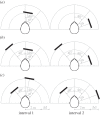Echolocation versus echo suppression in humans
- PMID: 23986105
- PMCID: PMC3768302
- DOI: 10.1098/rspb.2013.1428
Echolocation versus echo suppression in humans
Abstract
Several studies have shown that blind humans can gather spatial information through echolocation. However, when localizing sound sources, the precedence effect suppresses spatial information of echoes, and thereby conflicts with effective echolocation. This study investigates the interaction of echolocation and echo suppression in terms of discrimination suppression in virtual acoustic space. In the 'Listening' experiment, sighted subjects discriminated between positions of a single sound source, the leading or the lagging of two sources, respectively. In the 'Echolocation' experiment, the sources were replaced by reflectors. Here, the same subjects evaluated echoes generated in real time from self-produced vocalizations and thereby discriminated between positions of a single reflector, the leading or the lagging of two reflectors, respectively. Two key results were observed. First, sighted subjects can learn to discriminate positions of reflective surfaces echo-acoustically with accuracy comparable to sound source discrimination. Second, in the Listening experiment, the presence of the leading source affected discrimination of lagging sources much more than vice versa. In the Echolocation experiment, however, the presence of both the lead and the lag strongly affected discrimination. These data show that the classically described asymmetry in the perception of leading and lagging sounds is strongly diminished in an echolocation task. Additional control experiments showed that the effect is owing to both the direct sound of the vocalization that precedes the echoes and owing to the fact that the subjects actively vocalize in the echolocation task.
Keywords: auditory; binaural hearing; reverberation; temporal processing.
Figures



Similar articles
-
Human Exploration of Enclosed Spaces through Echolocation.J Neurosci. 2017 Feb 8;37(6):1614-1627. doi: 10.1523/JNEUROSCI.1566-12.2016. Epub 2017 Jan 10. J Neurosci. 2017. PMID: 28073936 Free PMC article.
-
Blind people are more sensitive than sighted people to binaural sound-location cues, particularly inter-aural level differences.Hear Res. 2016 Feb;332:223-232. doi: 10.1016/j.heares.2015.09.012. Epub 2015 Oct 1. Hear Res. 2016. PMID: 26433052
-
Aural localization of silent objects by active human biosonar: neural representations of virtual echo-acoustic space.Eur J Neurosci. 2015 Mar;41(5):533-45. doi: 10.1111/ejn.12843. Eur J Neurosci. 2015. PMID: 25728174
-
Psychophysics of human echolocation.Adv Exp Med Biol. 2013;787:311-9. doi: 10.1007/978-1-4614-1590-9_35. Adv Exp Med Biol. 2013. PMID: 23716237 Review.
-
Echolocation in humans: an overview.Wiley Interdiscip Rev Cogn Sci. 2016 Nov;7(6):382-393. doi: 10.1002/wcs.1408. Epub 2016 Aug 19. Wiley Interdiscip Rev Cogn Sci. 2016. PMID: 27538733 Review.
Cited by
-
Discrimination of 2D wall textures by passive echolocation for different reflected-to-direct level difference configurations.PLoS One. 2021 May 27;16(5):e0251397. doi: 10.1371/journal.pone.0251397. eCollection 2021. PLoS One. 2021. PMID: 34043655 Free PMC article.
-
Quantifying the impact on navigation performance in visually impaired: Auditory information loss versus information gain enabled through electronic travel aids.PLoS One. 2018 Apr 26;13(4):e0196156. doi: 10.1371/journal.pone.0196156. eCollection 2018. PLoS One. 2018. PMID: 29698428 Free PMC article.
-
Comparing Echo-Detection and Echo-Localization in Sighted Individuals.Perception. 2021 Apr;50(4):308-327. doi: 10.1177/03010066211000617. Epub 2021 Mar 5. Perception. 2021. PMID: 33673742 Free PMC article.
-
A Device for Human Ultrasonic Echolocation.IEEE Trans Biomed Eng. 2015 Jun;62(6):1526-1534. doi: 10.1109/TBME.2015.2393371. Epub 2015 Jan 16. IEEE Trans Biomed Eng. 2015. PMID: 25608301 Free PMC article.
-
People's Ability to Detect Objects Using Click-Based Echolocation: A Direct Comparison between Mouth-Clicks and Clicks Made by a Loudspeaker.PLoS One. 2016 May 2;11(5):e0154868. doi: 10.1371/journal.pone.0154868. eCollection 2016. PLoS One. 2016. PMID: 27135407 Free PMC article. Clinical Trial.
References
-
- Stoffregen TA, Pittenger JB. 1995. Human echolocation as a basic form of perception and action. Ecol. Psychol. 7, 181–216 (doi:10.1207/s15326969eco0703_2) - DOI
-
- Diderot D. 1749. Letter on the blind for the use of those who see. In Diderot's early philosophical works (ed. Jourdain M.), pp. 68–141 New York, NY: Burt Franklin
-
- Supa M, Cotzin M, Dallenbach KM. 1944. ‘Facial vision’: the perception of obstacles by the blind. Am. J. Psychol. 57, 133–183 (doi:10.2307/1416946) - DOI
-
- Kohler I. 1964. Orientation by aural clues. Am. Found. Blind Res. Bull. 4, 14–53
-
- Kellogg WN. 1962. Sonar system of the blind. Science 137, 399–404 (doi:10.1126/science.137.3528.399) - DOI - PubMed
Publication types
MeSH terms
LinkOut - more resources
Full Text Sources
Other Literature Sources

